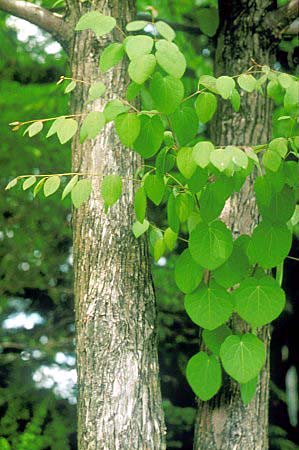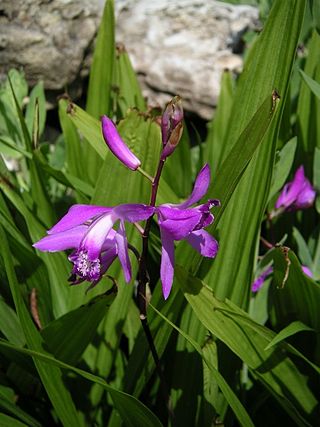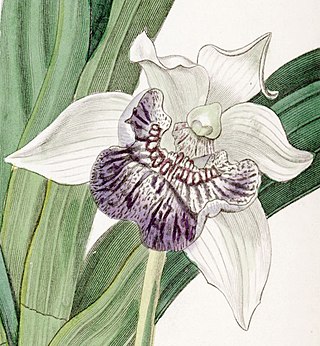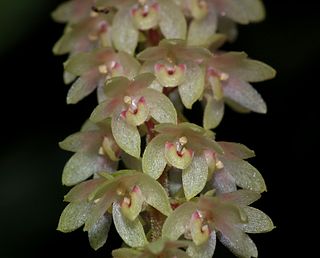
Orchids are plants that belong to the family Orchidaceae, a diverse and widespread group of flowering plants with blooms that are often colourful and fragrant.

In botany, a bulb is structurally a short stem with fleshy leaves or leaf bases that function as food storage organs during dormancy.

Bulbophyllum is a genus of mostly epiphytic and lithophytic orchids in the family Orchidaceae. It is the largest genus in the orchid family and one of the largest genera of flowering plants with more than 2,000 species, exceeded in number only by Astragalus. These orchids are found in diverse habitats throughout most of the warmer parts of the world including Africa, southern Asia, Latin America, the West Indies, and various islands in the Indian and Pacific Oceans. Orchids in this genus have thread-like or fibrous roots that creep over the surface of trees or rocks or hang from branches. The stem is divided into a rhizome and a pseudobulb, a feature that distinguished this genus from Dendrobium. There is usually only a single leaf at the top of the pseudobulb and from one to many flowers are arranged along an unbranched flowering stem that arises from the base of the pseudobulb. Several attempts have been made to separate Bulbophyllum into smaller genera, but most have not been accepted by the World Checklist of Selected Plant Families.

The pseudobulb is a storage organ found in many epiphytic and terrestrial sympodial orchids. It is derived from a thickening of the part of a stem between leaf nodes and may be composed of just one internode or several, termed heteroblastic and homoblastic respectively. All leaves and inflorescences usually arise from this structure. Pseudobulbs formed from a single internode produce the leaves and inflorescence from the top, while those that are formed from several internodes can possess leaves along its length. The modified sheath leaves that appear at the base of a pseudobulb and often enfold all or part of it are usually dry and papery, though in some orchids the sheaths bear leaf blades and the leaves at the pseudobulb's apex are reduced to scales.

Gongora, abbreviated Gga in horticultural trade, is a member of the orchid family (Orchidaceae). It consists of 65 species known from Central America, Trinidad, and tropical South America, with most species found in Colombia. They grow across a wide geographical range, from wet forests at sea level, to mountainous regions in the Andes, as high as 1,800 m.

Cercidiphyllum is a genus containing two species of plants, both commonly called katsura. They are the sole members of the monotypic family Cercidiphyllaceae. The genus is native to Japan and China and unrelated to Cercis (redbuds).

Anguloa, commonly known as tulip orchids, is a small orchid genus closely related to Lycaste. Its abbreviation in horticulture is Ang. This genus was described by José Antonio Pavón and Hipólito Ruiz López in 1798. They named it in honor of Francisco de Angulo, Director-General of Mines of Spain.
A storage organ is a part of a plant specifically modified for storage of energy (generally in the form of carbohydrates) or water. Storage organs often grow underground, where they are better protected from attack by herbivores. Plants that have an underground storage organ are called geophytes in the Raunkiær plant life-form classification system. Storage organs often, but not always, act as perennating organs which enable plants to survive adverse conditions.

Miltonia, abbreviated Milt. in the horticultural trade, is an orchid genus comprising twelve epiphyte species and eight natural hybrids. The miltonias are exclusively inhabitants of Brazil, except for one species whose range extends from Brazil into the northeast of Argentina and the east of Paraguay.

Bletilla, common name urn orchid, is a temperate, terrestrial genus of orchids containing five currently recognized species distributed through China, Japan, Taiwan, south to Vietnam, Thailand and Myanmar. The name is actually a diminutive of Bletia because of the resemblance between the two genera even though Bletia is a New World genus. The genera JimensiaRaf. and PolytomaLour. ex Gomes are generally included into Bletilla. This genus is abbreviated Ble in trade journals.

The genus Cochleanthes is made up of 4 species of orchids native to Mexico, Central America, the West Indies and South America. The name Cochleanthes refers to the shape of the flower.

Maxillaria, abbreviated as Max in the horticultural trade, is a large genus of orchids. This is a diverse genus, with very different morphological forms. Their characteristics can vary widely. They are commonly called spider orchids, flame orchids or tiger orchids. Their scientific name is derived from the Latin word maxilla, meaning jawbone, reflecting on the column and the base of the lip of some species, that may evoke a protruding jaw.

Encyclia is a genus of orchids. The genus name comes from Greek enkykleomai, referring to the lateral lobes of the lip which encircle the column. It is abbreviated as E. in the horticultural trade.

Leptotes, abbreviated Lpt in horticultural trade, is a genus of orchids formed by nine small species that grow in the dry jungles of south and southeast Brazil, and also in Paraguay or Argentina. They are small epiphytic plants of caespitose growth that sometimes resemble little Brassavola, as they share the same type of thin terete leaves, though they are more closely related to Loefgrenianthus.

Myrmecophila is a genus of plants belonging to the family Orchidaceae. It is native to southern Mexico, Central America, the West Indies and Venezuela.

Aspasia, abbreviated as Asp. in the horticultural trade, is a genus of 7 species of orchids occurring from southern Mexico to southern Brazil. The genus is closely related to Miltonia and Brassia. Aspasia species have few medium size flowers of exquisite colors which are occasionally cultivated or used to produce artificial hybrids.

Bifrenaria, abbreviated Bif. in horticultural trade, is a genus of plants in family Orchidaceae. It contains 20 species found in Panama, Trinidad and South America. There are no known uses for them, but their abundant, and at first glance artificial, flowers, make them favorites of orchid growers.

Psychopsiella is a monotypic genus in the orchid family found only in the state of Rio de Janeiro in Brazil and near Caracas in Venezuela. It grows as an epiphyte in evergreen montane forests at elevations of 800 to 1,500 metres.

Broughtonia sanguinea, also known as blood red broughtonia is a plant in the genus Broughtonia, a member of the family Orchidaceae. It was named in 1813 by its first describer, Robert Brown, for 18th century English botanist Arthur Broughton.

Pinalia polyura, or many-tailed pinalia, is a member of the orchid family endemic to the Philippines. It is semi-pendulous and sympodial, with pseudobulbs that are 20 cm long, 1 cm in diameter, and somewhat club shaped. Each new growth begins halfway along the previous year's pseudobulbs, making the plant longer each year. Each pseudobulb has about 5 shiny, lanceolate leaves approximately 15 cm long and 2 cm wide. Inflorescences appear at the upper portion of the plant and are pendulous, about 10 cm long and bear up to 40 flowers each 1.5 cm in diameter. It grows as an epiphyte and sometimes as a semi-terrestrial plant at elevations to 2,400 meters.
























